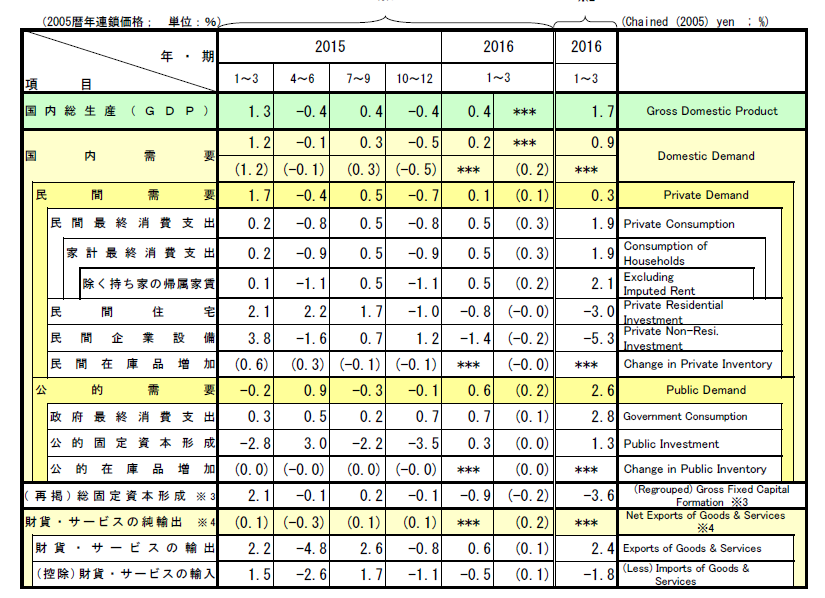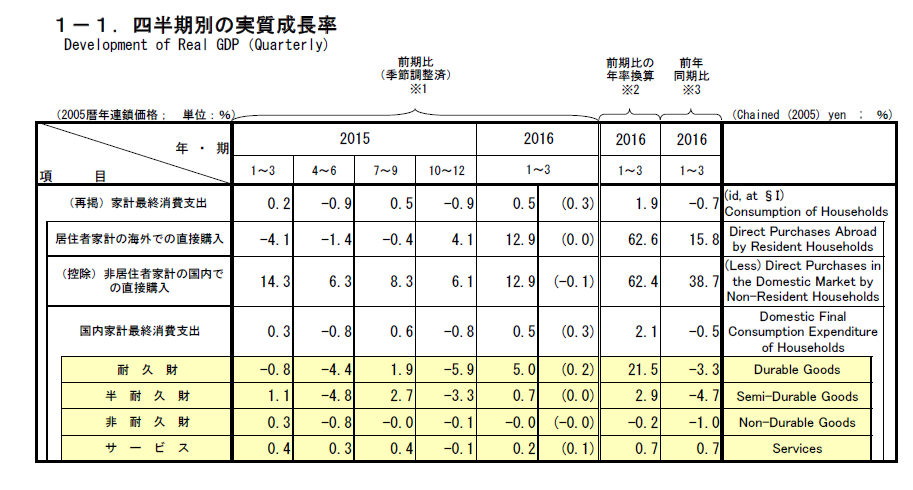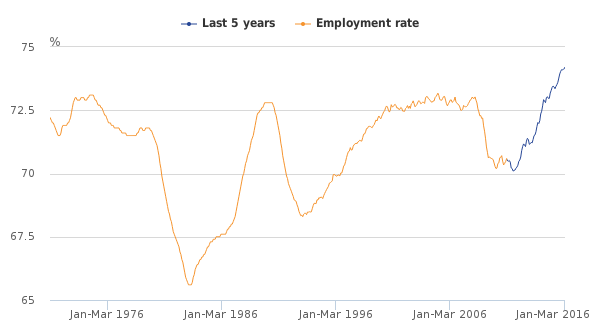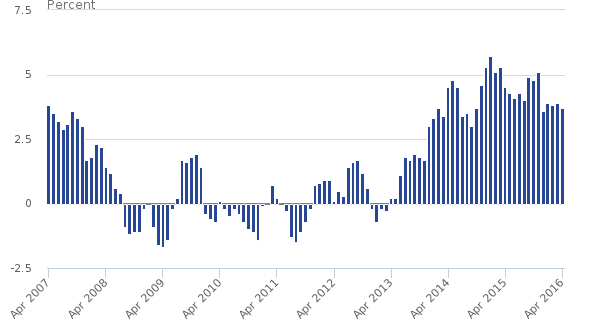This past week, three central banks released meeting minutes. The ECB reported on a fairly positive internal environment, while, for the first time in recent memory, the RBA focused on inflation. The Fed strongly hinted at a June rate hike. The remainder of the news was mostly positive.
For the first time in recent memory, Japanese economic news was positive. Industrial production increased a solid .7% M/M. And most importantly, 1Q GDP rose at a 1.7% annual pace (AR):

Exports increased at an encouraging 2.4% annual rate while household consumption rose 1.9% (AR). Unfortunately, investment contracted 5.3% (AR). But as the following table shows, underlying consumption expenditures remain weak: durable goods purchases decreased in 3 of the last 5 quarters, with two of those declines being especially sharp:

Despite this week’s good news, Japan is still in the middle of a two decade-long malaise, which is typified by a recent commercial where a company apologized for increasing prices:

There were two important EU news releases. The ECB released the minutes of their early March meeting, which contained the following observations of the EU economy:
- Household income increased 1.6% Q/Q in 3Q15 and 1.5% Q/Q in 4Q15.
- Household consumption growth was 1.8% Q/Q in 3Q15 and 1.5% in 4Q15.
- Industrial production increased 1.8% in the January/February period from 4Q15
- Retail sales rose .8% from 4Q15
- Employment in 4Q15 was up 1.2% Y/Y
- Wage gains were will weak, rising 1.3% in 3Q15 and 4Q15
- Non-financial companies gross capital fixed formation increased 3% in 3Q15 and 5.7% in 4Q15.
Overall, the picture wasn’t nearly as bad as some analysts argue. The second data point was inflation, which was a disappointing -2% M/M.
The primary news from Australia was the release of the latest meeting minutes, which confirmed the RBA is very concerned about weakening inflation:
Members discussed the extent to which the CPI data provided a signal about ongoing inflation trends. They noted that CPI data were less subject to measurement error than many other key data series. Moreover, the lower-than-expected CPI outcome could not be explained entirely by temporary factors and in fact was significantly driven by low price rises for non-tradable items. That in turn was consistent with a range of data suggesting quite subdued growth in labour costs (which had also been a bit weaker over 2015 than previously expected).
Members began their discussion of the Australian economy by discussing the March quarter consumer price index (CPI). They noted that inflation had been lower than expected. Various measures suggested that underlying inflation had declined to a little less than ¼ per cent, compared with about ½ per cent in the December quarter, to be about 1½ per cent over the year. Headline inflation had been lower still, partly reflecting a decline in fuel prices in the March quarter and over the year. Even so, the CPI data had indicated that weakness in domestic cost pressures had been broadly based. Non-tradables inflation had declined further in March to around its lowest year-ended rate since the late 1990s, reflecting low growth in labour costs and a range of other factors, including heightened retail competition, a moderation in conditions in housing rental and construction markets, and declines in the cost of business inputs such as fuel and utilities. The exchange rate depreciation over the preceding few years had continued to place some upward pressure on the prices of tradable items, although low wage growth and heightened retail competition appeared to have limited the extent to which higher import prices had become evident in retail prices. The prices of tradable items (excluding volatile items and tobacco) were little changed in the March quarter.
This is the most in-depth discussion about inflation taken by the RBA in the last 5 years. In the top paragraph, they note that CPI data is not only more reliable than most other economic releases but also that the recent CPI figures are less impacted by transitory factors. In the second paragraph, the participants discuss a range of inflation data points, concluding all are in one way or another declining at concerning rates. The logic exhibited in these two paragraphs naturally leads to the conclusion that the bank should lower rates to stimulate inflation.
Despite the uncertainty caused by the potential for a “Brexit,” UK news was positive. Unemployment remains at 5.1% -- a level it has maintained for the last 4 months:

Placing this data in a long-term perspective, the employment rate continues to post its highest numbers since the early 1970s:

The strong labor market is supporting consumer expenditures: retail sales increased 1.3% M/M and 4.3% Y/Y. The Office of National Statistics also calculates retail sales on a rolling 3-month basis – which is very useful considering this statistics potential volatility. That number continues to be very strong:

CPI was the only negative number, with the ONS reporting a .3% Y/Y rate. The good news is inflation rose from 0%; the bad news is it remains at very concerning levels.
